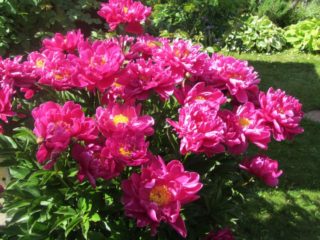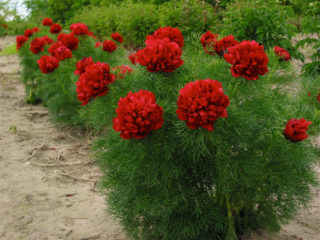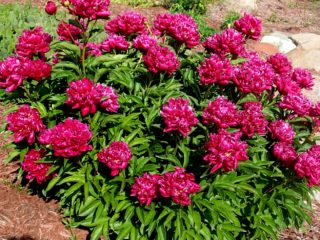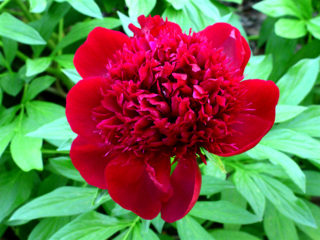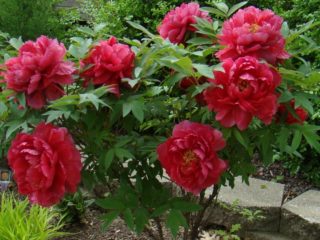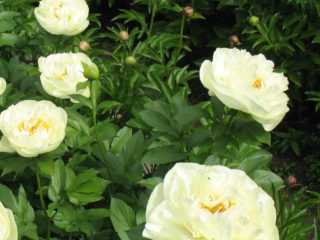Content
Peony Rosea Plena is an elegant and fragile flower that charges those around with its “pink mood”. It attracts the eye among the greenery of the flower garden in the garden. Its main advantages are its attractive appearance, unpretentiousness and resistance to low temperatures.
Description of peony Rosea Plena
"Rosea Plena" is a variety well known to many gardeners. This medicinal plant belongs to the group of herbaceous perennials. The height of the central shoots is 70-80 cm. The bush is medium-spreading with a spreading width of up to 90 cm. The stems are weak and require support. Peony grows in nests. The roots are dark brown in color and have spindle-shaped thickenings.
Photos and descriptions of Rosi Plena peonies can be found not only on gardening forums, but also on nursery websites, since the plant is very in demand and popular.

Peony flowers can be pink, red and white
Peony leaves are bright green with a shiny coating. The shape of the leaf blades is elongated, trifoliately dissected with a solid edge. The flowers are double, ruffled, with a structure reminiscent of crinkled silk in the “strawberries and cream” shade.
The fruits of "Rosea Plena" are multi-leafed with seed pods, each of which contains oval seeds of black or brown color. Fruiting can be observed from the 4th year of the crop’s life (September-October).
The Rosea Plena variety is not particularly demanding and can grow in areas with slight partial shade. However, in places with good lighting it shows a better development rate and an earlier flowering period.
The plant is a frost-resistant variety and can tolerate temperatures as low as -28 °C. Available for cultivation in the middle zone and northern regions. In the latter case, it requires measures to prepare for winter.
Features of flowering
The variety "Rosea Plena" belongs to the group of terry peonies. The diameter of the inflorescence (in bloom) reaches 12-14 cm. Each flower is a “construction” of supporting coral-pink petals and a large spherical cluster of smaller elements (petals) located on them. Flowers of the medicinal peony Rosea Plena tend to lighten towards the end of the flowering period.
The variety is characterized by early flowering (14-15 days earlier than other varieties of peonies). The culture shows the first blooming flowers already at the beginning of the first summer month, and by mid-June one can observe abundant and bright flowering of the entire bush. The aroma is delicate, light, with slight notes of sweetness.
The splendor of peony flowering depends on many factors. Most often this is affected by:
- correctly selected area for planting (lighting, drainage);
- planting depth (too close to the surface of the earth or, conversely, deep);
- age of the bush;
- timely removal of faded buds;
- composition and properties of soil (acidity);
- fertilizing (presence of nitrogen fertilizers);
- watering (lack of moisture negatively affects the splendor of flowering).
Compliance with all conditions will lead to abundant and bright flowering of the Rosea Plena bush.
Application in design
Peonies are actively used in landscape design as bright accents and central elements of flower beds and flower beds. The main requirement for the “neighbors” is similar conditions combined with smaller inflorescence sizes. In this case, the color scheme of the “partners” is not decisive.

Peony is good for cutting and landscape
Peony flowers are characterized by clear contours and shape, so the most organic beauty of the plant is emphasized by the lush, slightly chaotic green mass of its “neighbors.” However, Rosea Plena will not tolerate plants that grow too much, which could negatively affect its own growth.
Geranium is an excellent choice for companionship with peony. It is a little more modest than its bright neighbor, but at the same time it successfully emphasizes the shades and “doubleness” of the Rosea Plena flowers. The Compositae variety of geranium is suitable for this variety.
An ideal partner for the Rosea Plena peony is tansy, which emphasizes the openwork of pink flowers. Its small inflorescences contrast very well with the large buds of pink peony.
The right background for peonies is very important. A good example for varieties of coral-pink color would be catnip with purple flowers. Rosea Plena will create an excellent tandem with phlox, hosta, irises and daylilies. You can make an edging for a flower bed with peonies using squat violets, primroses and cuffs.
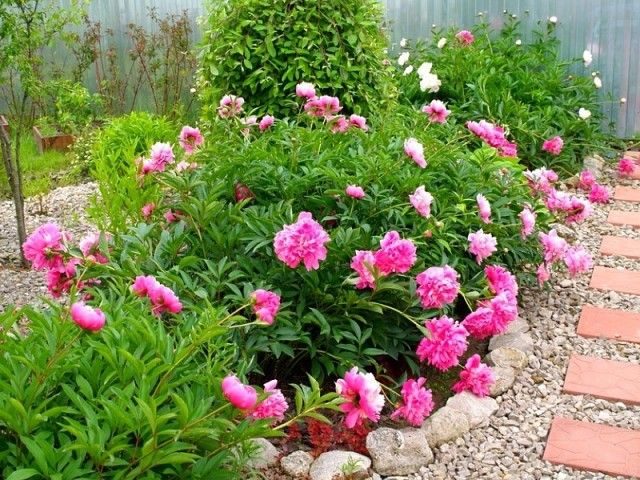
The plant may have a very early flowering period - May
Peonies "Rosea Plena" are an option for the garden, flower garden and personal plot, but not for a loggia or balcony. For apartments, it is better to choose lower-growing varieties with strong stems that do not require additional support.
Reproduction methods
Peonies "Rosea Plena" are propagated most often in 2 ways: by dividing the rhizome or by root cuttings.
In the first case, use a bush that is at least 5 years old. The optimal option is 7 years. The procedure begins at the end of August or beginning of September. During this period, the buds on the root system of the plant have already been formed, but root regrowth has not yet occurred.
The root system is washed and dried in the shade for 4-5 hours. After this, the bush is divided into “divisions”. In this case, 3-4 buds and 2-3 strong roots are left on each part (the rest are shortened). The last stage is treating the rhizomes with a fungicide and “powdering” with wood ash. After keeping the cuttings in the shade for a day, you can begin planting.
Root cuttings are pieces of roots with buds located on them. Planting is done directly into the ground at a distance of 15-20 cm from each other. The survival rate of cuttings is 75-80%.
Additional methods of reproduction are:
- seminal;
- cuttings;
- vertical layers.
These methods are more labor intensive and require significant gardening experience.
Planting the herbaceous peony Rosi Plena
Planting of Rosea Plena peonies is carried out mainly in the fall in the first ten days of September. Soil preparation begins a month before the procedure. Plants of this species prefer moderately dry, fertile soils. To begin, dig a planting hole measuring 60x60x60.Its bottom is lined with drainage material (broken brick, crushed stone or coarse sand).
The soil is mixed with superphosphate (200 g), compost, potassium sulfate (100 g), lime (100 g) and wood ash (300 g). The fertilized soil is poured back into the hole and left for several days. Once the soil has settled, you can begin planting. The rhizome of "Rosea Plena" is placed in the hole and carefully covered with garden soil, lightly compacting it. Then the “delenka” is watered.
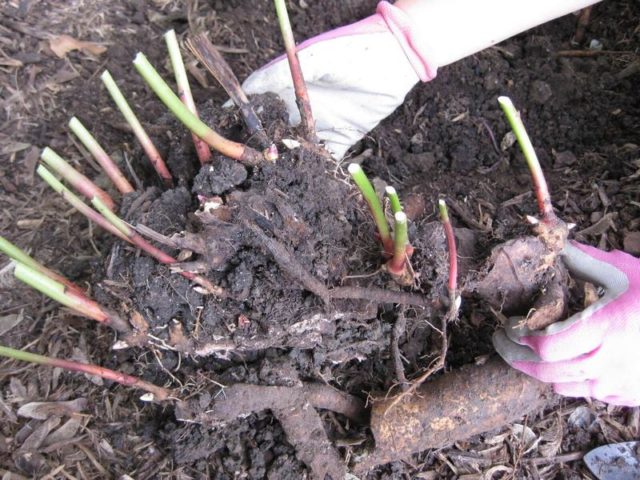
The plant loves light, so it needs to be planted in open sunny areas.
Rosea Plena peonies are known for their adaptive qualities. They don't bloom the first year, but don't worry.
Aftercare
Peonies "Rosea Plena" are moderately moisture-loving plants. One 5-year-old bush requires 20-30 liters of water. This is exactly how much is needed for the moisture to reach the base of the rhizome. The crop requires special watering in the spring, when buds are forming, and in the fall, at the time of the formation of young buds. Peonies are watered at the root, the soil around the bush is pre-loosened.
As for feeding, at the beginning of growth the variety is fertilized with ammonium nitrate (15 g per 12 l). From mid-May, water-soluble mineral complexes are used for irrigation. This procedure is carried out once every 30 days. At the moment of bud formation, fertilizing is done with potassium-phosphate complexes. In summer, the plant is only watered and the weeds are weeded in the area next to the bush.
Preparing for winter
In the fall, after the first frosts, the bush is pruned, leaving small sections of stems with 3-4 leaf blades. This is a necessary condition for the formation of replacement kidneys.Since the Rosea Plena variety is classified as a frost-resistant species, it does not require shelter. However, it won’t hurt to hill up the bush.
However, only transplanted Rosea Plena can be covered with a layer of peat or humus (10-15 cm thick). But in the spring, before the first shoots appear, it is necessary to remove the covering layer or the plant will “mate.”
Pests and diseases
The peony variety Rosea Plena officinalis rarely gets sick. The culture has good immunity to most diseases. The main danger to peonies is the ring spot virus. The first symptom is the appearance of ringed streaks of green-yellow color on the leaf blades of the bush.
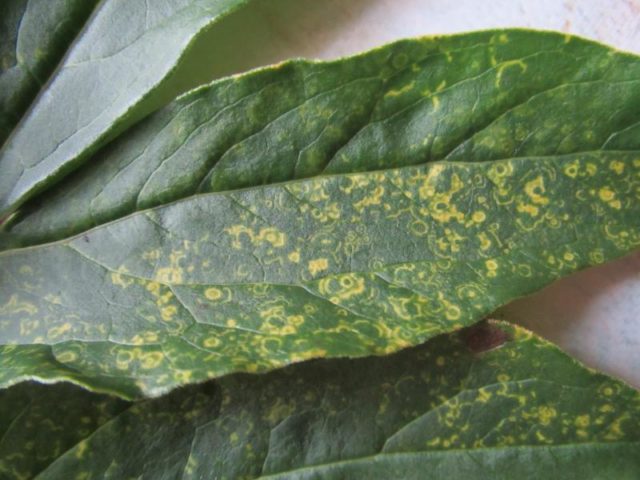
If the watering regime is violated, gray rot may appear.
In conditions of high humidity, gray rot may manifest itself. And if the wet period is accompanied by high temperatures, then rust may also appear, which reveals itself in the form of yellow-brown spots.
Of the insects, you should be wary of bronze beetles that feed on stamens and petals, nematodes that settle on roots, and ants that carry aphids. You can fight them with the help of drugs such as Aktara or Kinmiks.
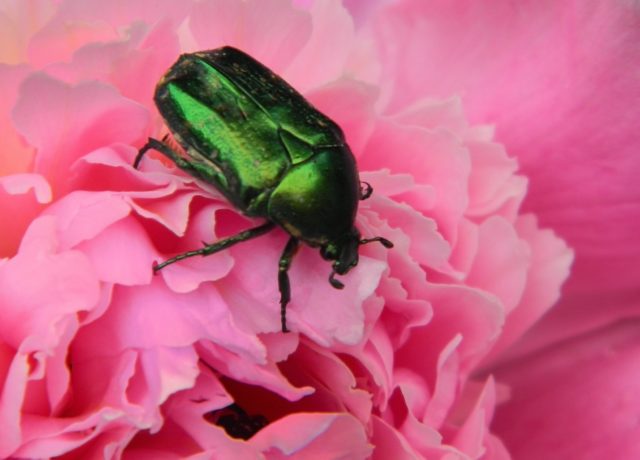
To get rid of insect pests you need to spray the buds with Fufanon solution
As for viruses, if they are infected, you should get rid of the diseased bush, since it is almost impossible to cure it. Fitoverm has proven itself to be effective against rot and rust. As a preventive measure, you can use “Skor” or “Chorus”.
Conclusion
Peony Rosea Plena is a crop that is always popular with both beginners in gardening and more experienced peony fans. Its bright appearance and ease of care make this variety an ideal tool for creating landscape design.
Reviews of peony Rosea Plena
Almost all reviews about Rosi Plena peonies are admiringly positive.
https://www.youtube.com/watch?v=DX0-hsK6qDM&feature=emb_logo
